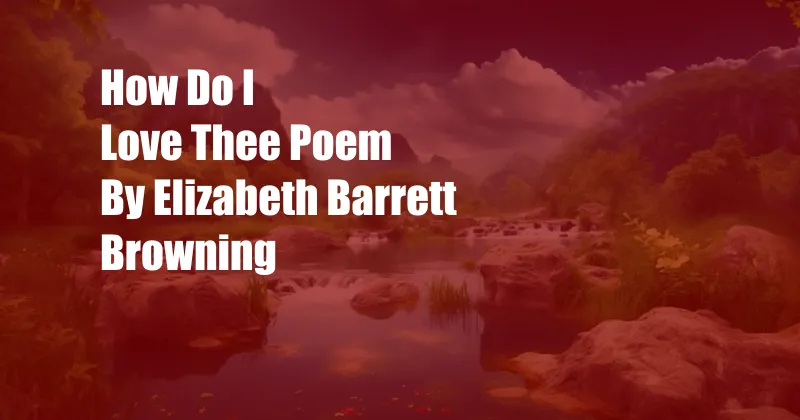
**How Do I Love Thee? Let Me Count the Ways: A Poetic Exploration of Elizabeth Barrett Browning’s Masterpiece**
In the realm of literature, few poems have captured the essence of love as profoundly as Elizabeth Barrett Browning’s “How Do I Love Thee?” Penned in 1845, this sonnet has become an enduring masterpiece, celebrated for its heartfelt expression of affection and its evocative language.
This article delves into the depths of Barrett Browning’s poetic masterpiece, exploring its historical context, intricate structure, and timeless themes. As we navigate the poem’s captivating verses, we’ll unravel the myriad ways in which the speaker’s love unfolds, painting a vibrant tapestry of emotions.
**Unveiling the Depths of Love’s Expression**
“How Do I Love Thee?” presents a glimpse into the heart of a lover, who seeks to articulate the boundless nature of their affection. With each line, the speaker enumerates a distinct aspect of their love, ranging from the depths of their soul to the very fabric of existence.
Through a series of rhetorical questions, the speaker contemplates the immeasurable nature of their love: “I love thee to the depth and breadth and height / My soul can reach, when feeling out of sight.” Here, love is depicted as a vast and boundless expanse, extending beyond the limitations of human understanding.
**The Sonnet’s Intricate Structure**
Barrett Browning’s sonnet adheres to the traditional Petrarchan sonnet form, consisting of 14 lines divided into an octave (eight lines) and a sestet (six lines). The octave establishes the speaker’s love as multifaceted and all-encompassing, while the sestet contrasts this immense affection with the speaker’s willingness to endure hardship for their beloved.
The poem’s rhyme scheme, consisting of an ABBA ABBA CDCDCD pattern, creates a sense of harmony and rhythm. This structure complements the poem’s lyrical flow, inviting readers to immerse themselves in the speaker’s emotions and reflections.
**Evolution and Impact of the Poem**
Since its publication, “How Do I Love Thee?” has had a profound impact on literature and popular culture. Its romantic and idealized portrayal of love has inspired countless adaptations, including musical settings, recitals, and literary references.
The poem’s themes of unwavering devotion and the transformative power of love continue to resonate with audiences today. It has become a timeless expression of human emotion, transcending cultural and linguistic barriers.
**Expert Insights and Practical Tips**
To fully appreciate the beauty of “How Do I Love Thee?,” consider these expert insights and practical tips:
**Read aloud:** Experience the poem’s rhythmic flow and musicality by reading it aloud. Allow the words to wash over you, paying attention to the nuances of the language.
**Reflect on the speaker’s emotions:** Immerse yourself in the speaker’s perspective. What do their words reveal about their feelings and the depth of their love? Consider the emotions that are conveyed directly and those that are subtly hinted at.
**Frequently Asked Questions (FAQs)**
**Q: What is the significance of the phrase “I love thee freely”?**
**A:** By “freely,” the speaker suggests that their love is not contingent on any external factors or expectations. It is a selfless and unconditional love that flows without restraint.
**Q: How does the poem explore the themes of mortality and eternity?**
**A:** The speaker’s love transcends the boundaries of time. They declare, “I love thee with a love I seemed to lose / With my lost saints.” Here, love is portrayed as an enduring force that defies both personal loss and the passage of time.
**Conclusion**
Elizabeth Barrett Browning’s “How Do I Love Thee?” stands as a testament to the enduring power of love. Through its eloquent verses, the speaker articulates the boundless nature of this profound human emotion, inspiring generations of readers with its lyrical beauty and heartfelt sincerity.
Are you drawn to the themes and emotions explored in this article? Let us know your thoughts and interpretations in the comments section below.